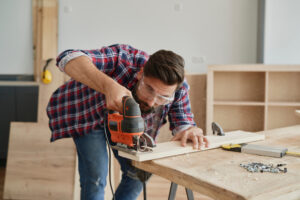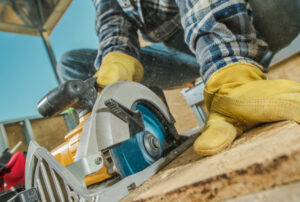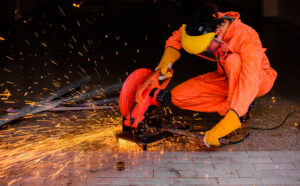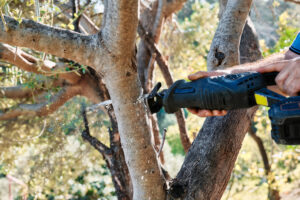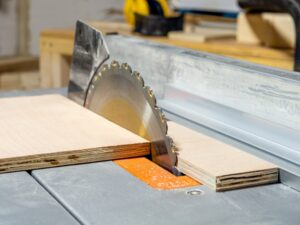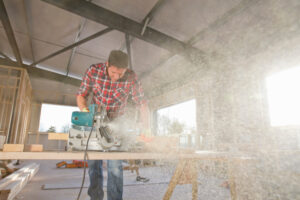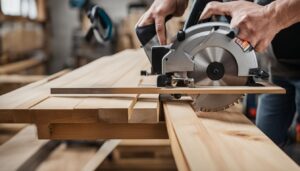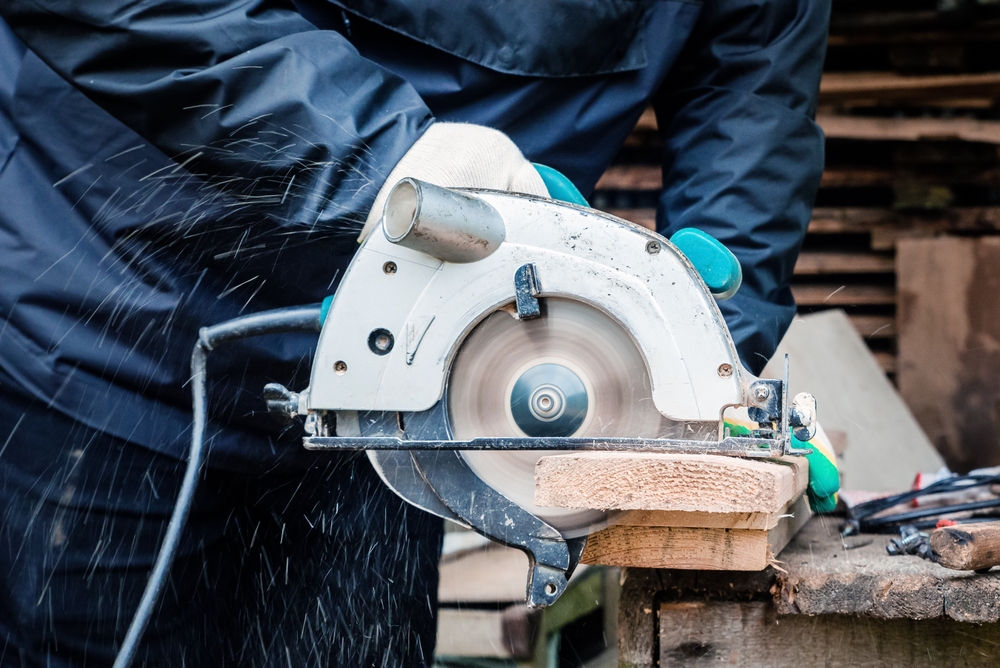
When using a circular saw, it’s important to prioritise safety. By following proper techniques and taking necessary precautions, you can ensure secure and efficient cuts. Here are some tips to help you secure workpieces on a circular saw:
Key Takeaways
- Properly securing workpieces on a circular saw is crucial for safety and accuracy.
- Ensure the workpiece is firmly clamped or supported to prevent movement during cutting.
- Use appropriate accessories such as push sticks and featherboards to maintain control and distance from the blade.
- Regularly inspect the workpiece and remove any foreign objects that may interfere with the cutting process.
- Always wear appropriate safety gear, including eye protection and gloves, when operating a circular saw.
Getting to Know Your Circular Saw
Before using a circular saw, it is important to familiarise yourself with its parts and functions. Understanding the different components will help you operate the tool efficiently and safely. Here are the key parts of a circular saw:
Main Parts of a Circular Saw
1. Blade: The blade is arguably the most important part of a circular saw. It is responsible for cutting through materials. Circular saw blades come in various sizes and tooth configurations to suit different cutting needs.
2. Motor: The motor is the powerhouse of the circular saw. It drives the blade, allowing it to rotate and make cuts. Motors in circular saws can vary in power and can be either corded or cordless.
3. Base Plate or Shoe: The base plate, also known as the shoe, provides stability and support to the saw while making cuts. It is usually made of durable materials like aluminium or steel.
Additional Features and Controls
4. Depth Adjustment: Most circular saws have a depth adjustment feature that allows you to control the depth of the cut. This feature is useful when you need to make precise cuts or when working with different thicknesses of materials.
5. Bevel Adjustment: The bevel adjustment feature allows you to tilt the base plate to make bevel cuts at various angles. It is particularly handy when working on angled cuts and edge beveling.
6. Safety Features: Circular saws often come equipped with safety features such as blade guards, electric brakes, and trigger locks to ensure safe operation and prevent accidents.
Familiarising yourself with these parts and features of a circular saw will help you operate the tool efficiently and get the most out of its capabilities.
Choosing the Right Circular Saw Blade
When it comes to achieving clean and accurate cuts with a circular saw, choosing the right blade is crucial. The type of circular saw blade you use will depend on the specific application and material you are cutting. Here are some common types of circular saw blades and their uses:
1. Rip-Cut Blades
Rip-cut blades are designed for cutting along the grain of the wood. These blades typically have fewer teeth and larger gullets, allowing for fast and efficient cutting. They are ideal for making long, straight cuts, such as when ripping boards or plywood.
2. Crosscut Blades
Crosscut blades are designed for cutting across the grain of the wood. These blades have more teeth and smaller gullets, which helps to produce smoother and cleaner cuts. They are suitable for making precise cuts, such as when cutting joints or trimming wood pieces.
3. Combination Blades
Combination blades, as the name suggests, are versatile and suitable for both rip-cutting and crosscutting. They have a mix of teeth sizes and configurations, allowing them to handle a variety of cutting tasks. Combination blades are a good option if you need to perform different types of cuts frequently.
4. Plywood Blades
Plywood blades are specifically designed for cutting plywood and other sheet materials. These blades usually have more teeth with a high tooth count, which helps to prevent splintering and produce clean cuts on both sides of the material. If you work with plywood often, using a plywood blade will yield the best results.
5. Specialty Blades
In addition to the standard blades mentioned above, there are also speciality blades available for specific applications. For example, there are blades for cutting non-ferrous metals, laminates, plastics, and even masonry. These speciality blades are designed with unique tooth configurations and materials to handle the specific challenges posed by these materials.
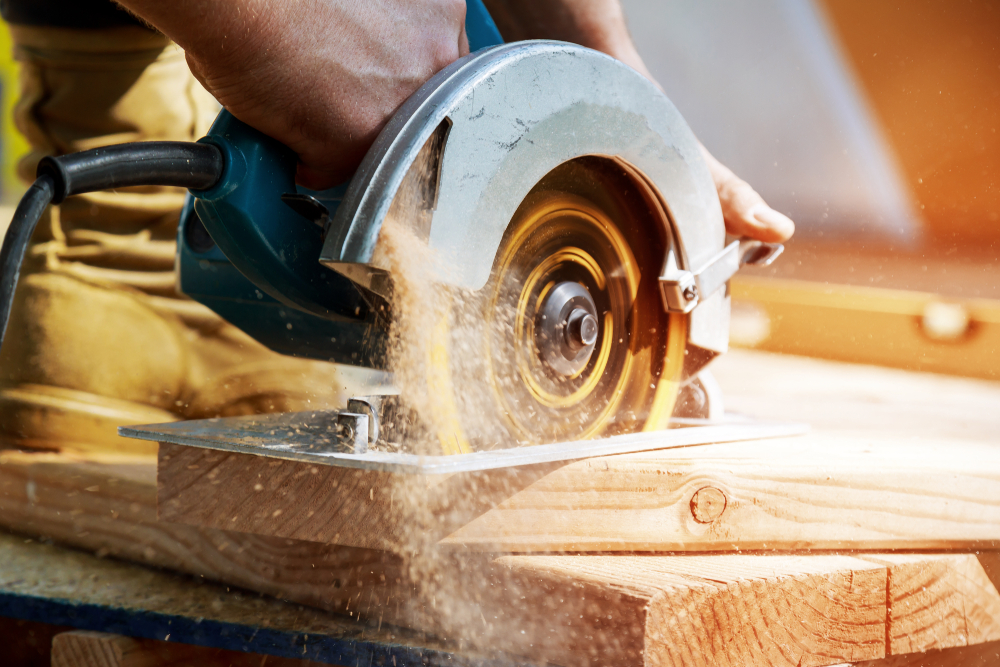
| Type of Circular Saw Blade | Uses |
|---|---|
| Rip-Cut Blades | Long, straight cuts along the grain of the wood |
| Crosscut Blades | Precise cuts across the grain of the wood |
| Combination Blades | Versatile for both rip-cutting and crosscutting |
| Plywood Blades | Cutting plywood and other sheet materials |
| Specialty Blades | Specific applications like cutting non-ferrous metals, laminates, plastics, or masonry |
By choosing the right circular saw blade for your specific cutting needs, you can achieve cleaner, more precise cuts and improve the overall efficiency and safety of your woodworking projects.
Using a Circular Saw Safely
When operating a circular saw, it is crucial to prioritise safety to avoid accidents and injuries. By following proper cutting techniques and taking necessary precautions, you can ensure a secure working environment. Here are some important steps to safely use a circular saw:
1. Wear the Right Safety Gear
Before using a circular saw, it is essential to wear the appropriate safety gear. This includes safety glasses or goggles to protect your eyes from flying debris, a dust mask to prevent inhalation of sawdust, and ear protection to minimise noise exposure. Additionally, wearing gloves and sturdy footwear will provide added protection.
2. Set Up a Stable Workstation
Before making any cuts, ensure that your workspace is properly set up for stability. Use a stable workbench or table to support the material you are cutting. If necessary, use clamps or other securing devices to firmly hold the workpiece in place. This will help prevent the material from shifting or falling during the cutting process.
3. Position Yourself Correctly
When using a circular saw, position yourself in a way that allows for maximum control and visibility. Stand firmly with your feet shoulder-width apart and keep a balanced stance. Maintain a comfortable grip on the saw’s handle, ensuring that both hands are securely positioned. This will provide better control and stability while making cuts.
4. Follow Proper Cutting Techniques
It is important to follow proper cutting techniques to ensure the best results and minimise the risk of accidents. Start by making sure the saw blade is properly aligned with the cutting line. Use a steady, controlled motion to guide the saw through the material, applying gentle pressure and allowing the blade to do the work. Avoid forcing the saw or making aggressive movements that may lead to kickback.
By following these safety precautions and techniques, you can confidently use a circular saw and achieve accurate and precise cuts without compromising your well-being. Remember to always prioritise safety and take the necessary measures to protect yourself and those around you.
| Cutting Technique | Description |
|---|---|
| Rip Cuts | These cuts are made parallel to the grain of the material. Start by measuring and marking the desired width of the cut. Use a straight edge or guide to help keep the saw on the cutting line. |
| Cross Cuts | These cuts are made perpendicular to the grain of the material. Measure and mark the desired length of the cut, ensuring the saw blade is aligned with the cutting line. Use a square or guide to maintain accuracy. |
| Mitre Cuts | Miter cuts are angled cuts made across the width of the material. They are commonly used for creating angled joints or decorative edges. Use a miter gauge or protractor to set the desired angle and guide the saw. |
Conclusion
Securing workpieces on a circular saw is crucial for ensuring workpiece safety. By following these tips and techniques, you can create a secure working environment and achieve precise results. Remember to prioritise safety by wearing appropriate protective gear and using the right blade for your cutting needs.
Throughout this article, I have highlighted the importance of workpiece safety when using a circular saw. By understanding the different parts and functions of the saw, choosing the right blade, and employing proper cutting techniques, you can enhance your woodworking experience.
I hope these tips have provided you with valuable insights and practical advice on how to secure workpieces effectively. By implementing these measures, you can confidently use a circular saw for your woodworking projects, knowing that you have taken the necessary precautions for workpiece safety. Happy woodworking!
FAQ
What are the key parts of a circular saw?
The key parts of a circular saw include the blade, guard, handle, trigger, and base plate.
How do I choose the right circular saw blade?
The type of circular saw blade you use will depend on the specific application and material you are cutting. Some common types of circular saw blades include rip blades for cutting along the grain, crosscut blades for cutting across the grain, and combination blades for general-purpose cutting.
What are the safety precautions for using a circular saw?
When using a circular saw, it is important to wear safety goggles, ear protection, and a dust mask. Make sure the saw is properly grounded and that the blade is sharp and clean. Always use the appropriate blade guard and never force the saw through the material.
How do I secure workpieces on a circular saw?
To secure workpieces on a circular saw, you can use clamps or vises to hold the material in place. Make sure the material is flat and stable before making any cuts. Avoid placing your hands near the blade and keep the workpiece firmly against the base plate.
- Drill Battery Maintenance: Essential Tips for Cordless Drill Battery Care - February 5, 2024
- Troubleshooting Drill Issues - February 5, 2024
- Quick Drilling Techniques - February 2, 2024

